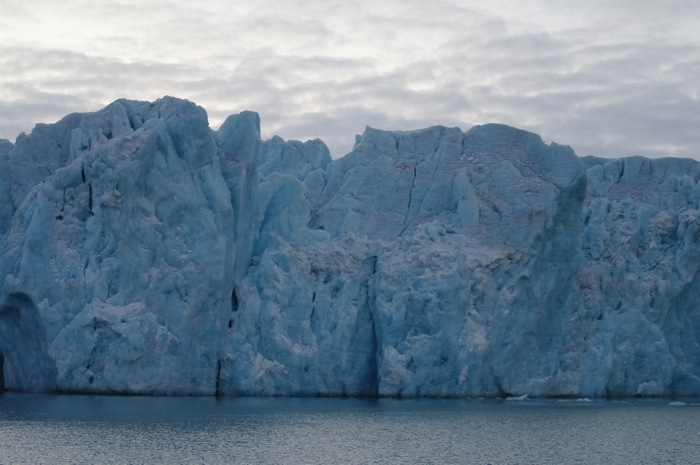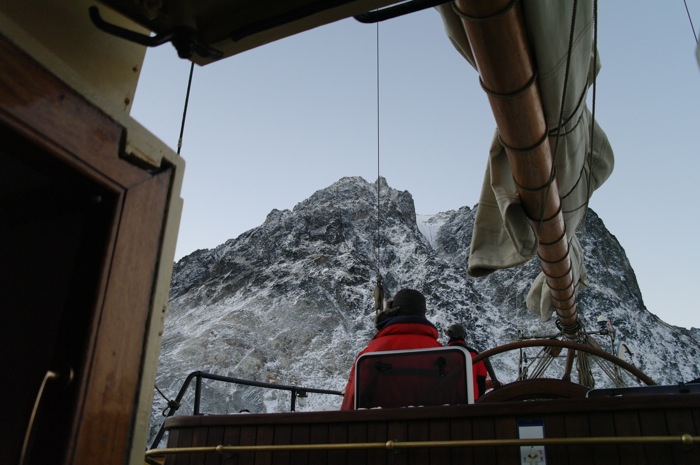13 October 2010 – around the north-west tip
 This big island, cleft a thousand times by deep fjords, and whorled from end to end with contour lines in black and white, is Spitsbergen: meaning simply ‘pointed mountains’. But on the map it looks more like a collapsing brain, falling apart at a thousand fault lines, dropped from the hands of a desolate sea.
This big island, cleft a thousand times by deep fjords, and whorled from end to end with contour lines in black and white, is Spitsbergen: meaning simply ‘pointed mountains’. But on the map it looks more like a collapsing brain, falling apart at a thousand fault lines, dropped from the hands of a desolate sea.
The computer screen has become a field of snow: its glare starts to move, the black characters speckling my vision like shoreline rocks. I give up and go on deck, watch while we slowly motor out towards the open ocean, past dead peaks between which are always glaciers, some reaching the sea, slow catastrophes; and others rounded off before reaching the water, their tongues blanketed with snow. At the bottom of one of these, extending across rocks and beach are long, deep scores, from rocks that have been dragged with older flows. They look like gigantic brown fingernail marks, dragged down to the sea.
As we pass by, the long and gentle scoop of those lines becomes a squiggled, vertical pattern marked upon a speckled black-and-whiteboard, the beach no longer at the end of a gradual slope but now merely an underline to the white glacier and the mountains. In the same way, I recognise the flat promontory of Gravneset, where we landed yesterday. But when we pass it, colliding with large chunks of ice as we go, it too is flattened to an unrecognisable verticality, and it is only after we’ve passed that the curved outer beach and bay, and the long curve around to Gullbreen, become again readable.
 I’m reading about distance perception, trying to understand not what, but how I am seeing: why everything here seems so close to itself, so utterly compressed into something that I can’t describe as seeming either ‘close’ to or ‘distant’ from me. The book is Perception and Behaviour in Strange Environments (bought online for its title alone!), by H E Ross. She describes ‘aerial perception’ as a cue to distance based on contrast perception; and varying with the amount of light-scattering particles in the atmosphere. So I wonder ignorantly whether here, the air is so utterly clear that things normally blurred become sharp, making everything then seem to be equally near??
I’m reading about distance perception, trying to understand not what, but how I am seeing: why everything here seems so close to itself, so utterly compressed into something that I can’t describe as seeming either ‘close’ to or ‘distant’ from me. The book is Perception and Behaviour in Strange Environments (bought online for its title alone!), by H E Ross. She describes ‘aerial perception’ as a cue to distance based on contrast perception; and varying with the amount of light-scattering particles in the atmosphere. So I wonder ignorantly whether here, the air is so utterly clear that things normally blurred become sharp, making everything then seem to be equally near??
There is also the issue, Ross says, of frames of reference: in the Arctic, all the usual cues to distance are absent. I come from a vast country where there are no high mountains, and I have always lived in a city. I have no prior knowledge, no bodily understanding, of any kind of ‘place like this’ – except for two-dimensional images; films, photos, and especially, paintings. It is strange to think that this perplexing and very physical flattening of all features may be, not some explicable atmospheric effect, but simply my personal experience of the world.
 I’m sick today, with a sore throat and runny nose – and I’m not the only one. The walk yesterday was gruelling, though at the time I placed one foot in front of the other and tromped with everyone else in single file across snow-covered, jutting rocks and treacherous smooth ones, up and down sharp inclines and crumbling declines, always following someone’s footsteps so as to place my boot somewhere sure. It was not possible to look at the landscape while walking: each time I tried I felt my feet stumble, felt the premonition of a snapped ankle and threw my gaze back to my feet.
I’m sick today, with a sore throat and runny nose – and I’m not the only one. The walk yesterday was gruelling, though at the time I placed one foot in front of the other and tromped with everyone else in single file across snow-covered, jutting rocks and treacherous smooth ones, up and down sharp inclines and crumbling declines, always following someone’s footsteps so as to place my boot somewhere sure. It was not possible to look at the landscape while walking: each time I tried I felt my feet stumble, felt the premonition of a snapped ankle and threw my gaze back to my feet.
We are not simply exerting ourselves on a conveyer belt of imagery. My body is part of an extreme and complex set of reactions, physical and psychological, which feel now like an incomprehensible machinery of cause and effect, a mesh of uncertainties and worries formed now into the certainty of viral infection. When I stopped walking yesterday, my two small fingers quickly went numb with the cold. I heard someone saying (true or false?) that there are not even any weather reports up here: it is too far from any regular shipping for anyone to bother making accurate predictions.


